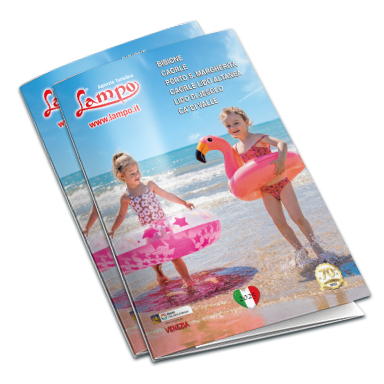Caorle is a picturesque beach resort on the Northern Adriatic Coast that can offer a unique blend of history, culture and natural wonders. The narrow streets in the enchanting Italian town wind their way between the colourful buildings in the old town centre down to the shore, where the views are breathtaking. It’s an ideal destination for an amazing holiday full of sun, sea and sand.
However, if you’ve chosen to spend your holidays in Caorle, as well as the wonderfully welcoming town itself, we also recommend spending a few hours or days visiting the many interesting sights in the surrounding area.
Keep reading to find out about some of the main attractions in Caorle and discover the hidden treasures surrounding the spellbinding resort.
What to see in Caorle
The Cathedral of Santo Stefano and its bell tower
One of the main landmarks in Caorle is its majestic Cathedral, which is dedicated to Saint Stephen. Dating back to circa 1038, the magnificent religious building presents a mixture of architectural styles, including Romanesque features and elements reminiscent of Byzantine Ravenna. Also dedicated to Saint Stephen, the bell tower of Santo Stefano that stands next to the cathedral is 48 metres high and boasts spectacular, sweeping views of the town and the sea.
Regular guided tours are organized to illustrate the history and distinctive features of the site. To book, contact the parish of Santo Stefano by emailing caorle@patriarcatovenezia.it or calling +39 0421 81028.
As part of a striking, eagerly awaited coastal tradition, an unmissable event called the “Fire in the Bell Tower” takes place on the second weekend in July every year.
Levante and Ponente beaches
Caorle is famous for the gorgeous, golden sand on its beach. It’s divided into eastern and western stretches – respectively known as the Levante and Ponente beaches – by the iconic Sanctuary of the Madonna dell’Angelo: a little seafront church near the old town centre.
With fine sand that slopes gently down into the water, it’s a perfect place to relax, sunbathe, take a dip, play on the shore or go for romantic strolls. On the seafront promenade, there are numerous beach resorts, restaurants, cafés and bars where you can savour delicious fresh seafood.
If you come on holiday with your dog, there are two special areas of the beach where your four-legged friends will find absolutely everything they need: one is on Lungomare Trieste near section 9 of Levante beach and the other is in the Green Oasi section of Ponente beach, next to the Santa Margherita municipal campsite.

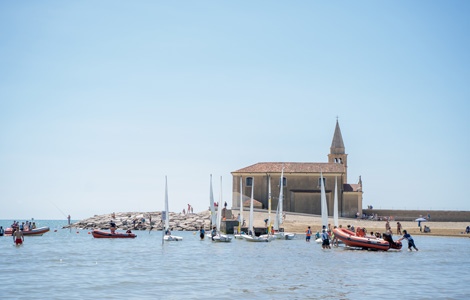
Living Rocks
The famous “Living Rocks” in Caorle are a stunning and totally original sight that we’d highly recommend to sculpture enthusiasts – and everyone else, too! After all, it isn’t every day that you see rocks on the seafront that have been carved into genuine works of art.
It’s all part of a truly unique initiative that began in July 1992, when a sculptor from Treviso called Sergio Longo – who was particularly fond of Caorle – picked up a hammer and chisel, and started work on the first sculpture, thus commencing the transformation of the huge blocks by the sea into outdoor works of art.
Since then, numerous international artists have carved the rocks into entrancing creations that fit in perfectly with the natural landscape.
A stroll down by the Living Rocks is an incredible, magical experience. If you visit during the Symposium, you can even see new works of art being created. In 2023, it took place from 20 June to 1 July.
The Sanctuary of the Madonna dell’Angelo
The Sanctuary of the Madonna dell’Angelo is a building of great historic and religious importance that is very dear to the people of Caorle.
Outside the door of this small, aisleless church is a little portico that has three statues on top of it, with Saint Michael the Archangel in the middle.
Over the years, the sanctuary became a site of pilgrimage. According to local tradition, one day children from the town spotted a wooden statue of the Madonna and Child floating in the sea, even though it was standing on a heavy marble pedestal. They took it to Caorle cathedral, but it mysteriously disappeared from there and turned up inside the sanctuary.
Although it is small, the church contains a number of exceptionally beautiful works of art. It is open from early in the morning until 11:00 pm in the summer and during the daytime in the winter.
Adding the finishing touch to the charming building is the nearby Romanesque bell tower, which also served as a lighthouse for the harbour. The sweeping views from the top are marvellous.
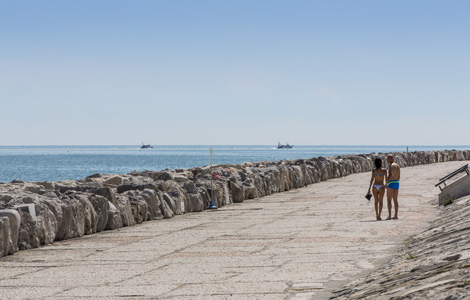
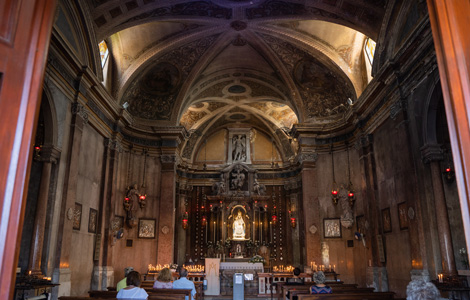
Caorle lagoon
Caorle lagoon is a unique ecosystem with a wealth of biodiversity. Migratory birds, fish and other wildlife all come here to live and breed in the ideal habitat provided by the natural environment.
Fishermen once lived here with their families in traditional homes called “casoni” that can still be seen today.
You can explore part of the lagoon by walking or cycling along the “Casoni trail”, which starts on the strip of land east of Caorle and goes back up along the Nicesolo canal. It’s a great way to admire the beautiful natural sights while revelling in the peace and quiet in an enchanting area. Discover the hidden secrets and natural beauty of the picturesque place that is known locally as the “Fishermen’s Island”!
Another way to explore the lagoon is on board one of the boats that take passengers out on tours from Caorle fishing harbour. For information, call Motonave Arcobaleno on +39 340 7700052.
Vallevecchia Conservation Area
The Vallevecchia Conservation Area is a nature reserve spanning more than 900 hectares that lies near Caorle, on the other side of the Nicesolo Canal. It provides a variety of habitats for many species of flora and fauna, including sand dunes, pine woods and marshland. Thanks to the conservation area’s clearly marked trails, you can venture into the heart of the unblemished natural environment.
Find out how to get to Vallevecchia!

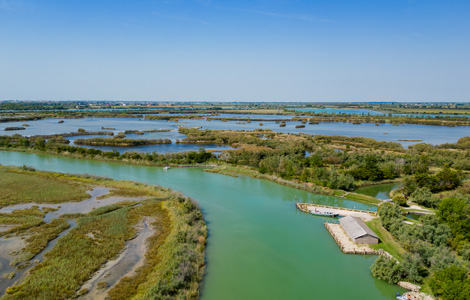
What to see near Caorle
If you’re already familiar with Caorle but you’d like to explore the surrounding area, take a look at our selection of nearby places where you can go for a pleasant day trip.
The village of Ca’ Corniani
Caorle is just a few kilometres away from the quaint old farming village of Ca’ Corniani, where a peaceful rural atmosphere prevails among the surrounding fields and vineyards.
With 1,770 hectares of cultivated land, it is considered one of the biggest farms in Italy today. It’s also the ideal place for cycling enthusiasts because it boasts no fewer than 10 kilometres of cycle paths (with 32 kilometres scheduled to be built in total).
There’s a rental service for those who don’t have their own bikes and there are places where you can stop for a rest and buy refreshments all along the path.
You’ll see a number of historic buildings on your ride, including an old pumping station that’s now a museum with an app-based entrance system which is open to everyone.
Between the fields are 5 kilometres of pollinator strips to aid bees, with plants that flower in both the summer and the winter.
Also found along the route are three works of “land art” that mark the entrances to the estate: a golden roof on an old farmhouse, a selection of statues of dogs and horses and LED words that light up every time lightning strikes on Italian soil.
Finally, make sure you go to see the Genagricola Farming Centre and its renovated Historic Winery.
Veneto villas
There are more than 3,800 historic villas dating back to the era of the Republic of Venice in Veneto, as well as more than 400 in Friuli.
The villas are surrounded by magnificent gardens and the interiors are adorned with beautiful frescoes and antique furniture. Immerse yourself in the elegance of Palladian architecture and the history of Venetian nobility by visiting these glorious homes.
The first villas were Gothic buildings that were very spacious and surrounded by the estates that rich Venetian merchants had bought with their fortunes and then had to manage.
As well as summer homes and bases for overseeing production activities, the villas were subsequently also used to demonstrate the wealth of their owners. They reached their pinnacle in the “Palladian” period, when the best known villas that were built were almost on a par with the much more famous French royal residence in Versailles. Many of them were built near waterways, such as the Brenta river.
Some of the most marvellous of the many Veneto Villas are listed below:
- VILLA PISANI, near Stra
It has no fewer than 11 hectares of beautiful grounds, stables, a maze with a tower in the middle, and a huge ballroom adorned with a majestic fresco by Giovanni Battista Tiepolo. Now home to a national museum, it contains 168 rooms and spans 15,000 m².
The villa’s within easy reach of the motorway (take the Mirano/Dolo exit on the Mestre bypass) and it takes around five minutes to walk there from the centre of Stra.
It’s open from Tuesday to Sunday, from 9:00 am to 8:00 pm (last entry one hour before closing). Ticket prices are as follows:
- Villa and grounds: €12.00
- People aged 18 to 25: €2.00
- Grounds only: €6.00
- VILLA LA ROTONDA, near Vicenza
The name “La Rotonda” means “The Rotunda” and it’s a reference to the stunning dome, which is similar to the one on the Pantheon in Rome. Designed by Palladio with the utmost attention to detail, it has been a UNESCO World Heritage Site since 1994 and is one of the most famous creations in the architectural world. A wealth of frescoes and stucco work can be found inside.
The villa stands on a hill and is in perfect harmony with the surrounding countryside. There are marvellous views of the landscape from the porticoes.
Villa La Rotonda is open to visitors every Friday, Saturday and Sunday
from 10:00 am until 12:00 noon and from 3:00 pm until 6:00 pm.
The standard price for an entrance ticket is €10.00.
- VILLA CONTARINI, Piazzola sul Brenta
Villa Contarini is one of the biggest and most beautiful 16th century stately homes in Veneto. In terms of its size and features, it’s comparable to a royal palace. It has more than 40 hectares of grounds behind it and the interior is bursting with frescoes and stucco work.
There are many breathtaking rooms inside and one that you definitely shouldn’t miss is the Music Room (also known as the Upside-down Guitar Room). Marco Contarini had it built to host exceptional music performances for his guests.
- Opening times:
- Summer (01/03 – 31/10): 9:00 am – 7:00 pm (last entry at 6:00 pm) – Closed on Wednesdays
- Winter (01/11 – 28/02): 10:00 am – 4:00 pm (last entry at 3:00 pm) – Closed on Wednesdays
- Tickets: Adults: €10.00 – Concessions: €5.00 – Family ticket (2 adults and up to 3 children aged 14 or under): €20.00. It is advisable to book in advance.
Concordia Sagittaria
Step back in time to the Roman era during a visit to Concordia Sagittaria, which is approximately 20 km from Caorle.
Founded as “Iulia Concordia” in 42 BC, it was a remarkable ancient Roman military colony located at the meeting point between two important Roman roads: Via Annia, which connected Aquileia, Concordia, Altinum and Padua, and Via Postumia, which linked the two main Roman ports in Northern Italy, Genoa and Aquileia.
Traces from the past can still be seen today in the shape of several sections of the town walls, the forum, the spa and part of a bridge on the Via Annia.
The name “Sagittaria” refers to the fact that there was an arrow factory here in ancient times (“sagittae” is Latin for “arrows”).
In the main square, make sure you take the time to admire the 10th century Cathedral of Santo Stefano Protomartire and the Romanesque and Byzantine architecture of the baptistery. The cathedral stands on top of the remains of an Early Christian complex from ancient Iulia Concordia, which can be visited. It contains burial enclosures, paved courtyards and mosaic flooring.
Portogruaro
Located just 25 km from Caorle on the banks of the Lemene river, Portogruaro is a charming town where visitors can enjoy a blend of art, history and culture.
The old town centre has a medieval layout and three of the old gate towers from the town walls can still be seen: Torre San Giovanni, Torre San Gottardo and Torre Sant’Agnese.
The two main streets in the town centre are lined with numerous refined Italian Gothic and Renaissance buildings.
The unmissable sights include the Gothic-style town hall with its eye-catching merlons, the picturesque old mills on the Lemene river, and the Cathedral of Sant’Andrea with its leaning bell tower. Don’t forget to stop off in one of the many delightful bars and trattorias to sample some local specialities and drink a nice spritz cocktail.
After a relaxing break, you can take a stroll along the canals, look at the important finds from the Concordia Sagittaria area in the Concordia National Archaeology Museum, and admire the town’s enchanting architecture.
If you go to Portogruaro in late August or early September, you’re likely to come across young or established musicians rehearsing or performing in concerts as part of the renowned International Music Festival organized by the Santa Cecilia Music Foundation.
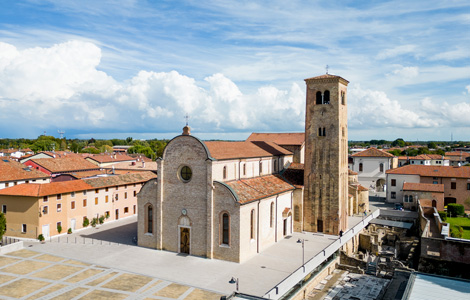
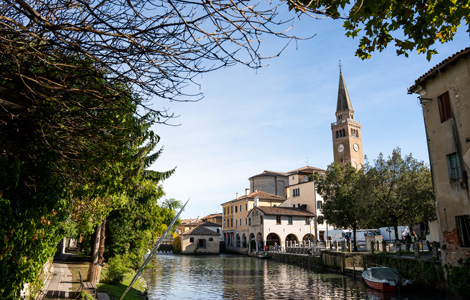
Enjoy a stay in Caorle with Agenzia Lampo
There’s a vast range of activities and places to discover in and around Caorle.
From the awe-inspiring historical monuments to the outstanding beaches, nature reserves and picturesque villages, there’s something to suit all tastes. Would you like to discover all of the spellbinding secrets of Caorle and the surrounding area? Start the travel experience now!
Plan your next adventure and get ready to explore all the wonders of this beguiling part of the world. What are you waiting for? Discover Caorle, fall under its spell and book your next holiday!
